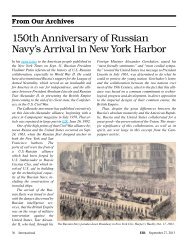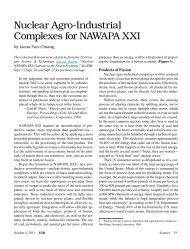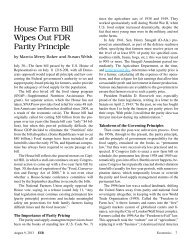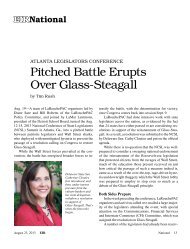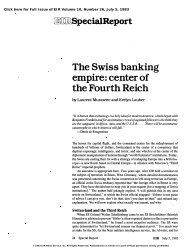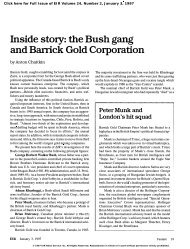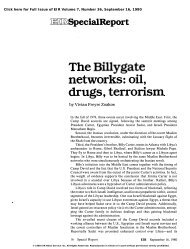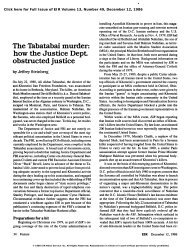View Full Issue - Executive Intelligence Review
View Full Issue - Executive Intelligence Review
View Full Issue - Executive Intelligence Review
Create successful ePaper yourself
Turn your PDF publications into a flip-book with our unique Google optimized e-Paper software.
Agriculture by Marcia Meny<br />
A chain reaction of crises<br />
The Department of Agriculture says not to worry, but droughtstricken<br />
farmers are demanding emergency measures.<br />
DeSPite the occasional July rains<br />
over the drought belt, there has been<br />
extensive damage to crops-especial<br />
ly to com and spring wheat, and to<br />
pastures and livestock. Don't believe<br />
the low damage estimates put out by<br />
the U. S. Department of Agriculture in<br />
July , for example , a projected 25%<br />
reduction in the com harvest. The true<br />
com harvest reduction may be 50% or<br />
more , as it was in the drought of 1983.<br />
You can see this for yourself in the<br />
photographs of stressed com plants on<br />
television.<br />
However, what most non-farmers<br />
may not be aware of is the chain-re<br />
action impact from the drought now<br />
taking place throughout the agricul<br />
ture sector, in terms of all other daily<br />
diet essentials-meat, milk, vegeta<br />
bles, and so forth . People may expect<br />
higher prices, but what if the food will<br />
not be there at any price?<br />
Congress is paying no heed to the<br />
disintegration process under way in<br />
the food chain. Only on the state and<br />
local level have some farmers taken<br />
the lead to issue recommendations on<br />
emergency measures to preserve the<br />
inventory and potential to produce. If<br />
these local initiatives become a na<br />
tional movement, then there is a chance<br />
to reverse the otherwise inevitable ca<br />
tastrophe . But time is running out.<br />
Consider the most obvious situa<br />
tion, the current crisis of the com<br />
acreage: Right now , there are millions<br />
of acres of standing com stalks across<br />
the cornbelt states-from Ohio west<br />
through Nebraska-that will produce<br />
EIR August 5, 1988<br />
no ears , or, perhaps, a few ears , and a<br />
few kernels per field. Because of the<br />
timing and severity of the drought this<br />
year, the pollination phase of the com<br />
plant has been a failure for much of<br />
the crop. Com devastated like this is<br />
not worth "growing out," and harvest<br />
ing for grain.<br />
When a national yield figure of<br />
com is quoted, for example, a predic<br />
tion that yields will be 50% of normal ,<br />
this means that some fields will pro<br />
duce at a reduced level, and some will<br />
not produce at all.<br />
In areas such as Wisconsin, and<br />
other parts of the "dairy belt," where<br />
com output is part of regionally inte<br />
grated farm practices involving pas<br />
tures, row-cropping, forage, and milk<br />
animal husbandry, the com plants can<br />
be chopped and stored for silage, and<br />
some fed to the cows fresh as "green<br />
chop," to which would then allow the<br />
burnt summer pastures time to regen<br />
erate . This makes use of the damaged<br />
com plants, and lessens the impact of<br />
the drought somewhat, but does not<br />
solve the problem of financial hard<br />
ship to the farmer, because high-pro<br />
ducing dairy herds need com and bigh<br />
quality feed in their diets . The price of<br />
this feed is soaring .<br />
However, in Iowa, the top com<br />
state in the nation (producing 23% of<br />
the U . S. com crop) , there are no large<br />
cattle herds for the com stalks to "feed<br />
through." In recent years , there has<br />
been a precipitous decline in beef herds<br />
in Iowa, which once was in the top<br />
three cattle-producing states in the na-<br />
tion, along with Texas and Oklahoma.<br />
(Hogs, the other top Iowa meat ani<br />
mal, do not digest cellulose in com<br />
stalks, while cattle do .)<br />
Therefore , thousands of Iowa<br />
farmers are facing the prospect ofhav<br />
ing to mow down, disc in, and plough<br />
up the com fields-an almost total<br />
waste . They do this to prevent "vol<br />
unteer" com from springing up next<br />
year, from any kernels that may form<br />
and drop from this year's disaster.<br />
(Com is planted annually from hy<br />
brid, not carryover, seed) .<br />
Instead of this waste, some Iowa<br />
farmers have appealed for emergency<br />
coordination through the state agricul<br />
ture extension offices, or otherwise,<br />
to both use the com for silage, and to<br />
preserve and expand the shrinking beef<br />
brood herd . Iowa com farmers could<br />
"billet" a certain number of beef ani<br />
mals per county. Young heifers , oth<br />
erwise now going to slaughter because<br />
of the burnt pastures, the high cost of<br />
feed, and the lack of water, could in<br />
stead be retained and grown to become<br />
breeding animals.<br />
There are thousands of empty sil<br />
os, empty livestock pens, and silage<br />
conveyer belts in Iowa that could han<br />
dle the livestock and their com silage.<br />
Nutrients are still intact in the com<br />
plants , and could provide rations to<br />
sustain the beef animals.<br />
In addition, emergency measures<br />
and financial assistance are required<br />
to maintain and expand the national<br />
dairy herd . The herd is now down to a<br />
record low of 8.8 million head, down<br />
from 11 million before the federal<br />
"Dairy Herd Termination Program"<br />
and the current drought cycle.<br />
In regions such as the Southwest,<br />
animal feed is not grown, but bought<br />
in bulk for local herds. Prices for feed<br />
(soybean oil meal, com) have already<br />
risen 70% this year. These animals<br />
will be going to slaughter, unless re<br />
lief is organized.<br />
Economics 13





